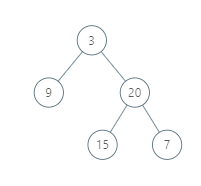Given a binary tree, return the vertical order traversal of its nodes values.
For each node at position (X, Y), its left and right children respectively will be at positions (X-1, Y-1) and (X+1, Y-1).
Running a vertical line from X = -infinity to X = +infinity, whenever the vertical line touches some nodes, we report the values of the nodes in order from top to bottom (decreasing Y coordinates).
If two nodes have the same position, then the value of the node that is reported first is the value that is smaller.
Return an list of non-empty reports in order of X coordinate. Every report will have a list of values of nodes.
Example 1:
Input: [3,9,20,null,null,15,7]
Output: [[9],[3,15],[20],[7]]
Explanation:
Without loss of generality, we can assume the root node is at position (0, 0):
Then, the node with value 9 occurs at position (-1, -1);
The nodes with values 3 and 15 occur at positions (0, 0) and (0, -2);
The node with value 20 occurs at position (1, -1);
The node with value 7 occurs at position (2, -2).
Example 2:

Input: [1,2,3,4,5,6,7]
Output: [[4],[2],[1,5,6],[3],[7]]
Explanation:
The node with value 5 and the node with value 6 have the same position according to the given scheme.
However, in the report "[1,5,6]", the node value of 5 comes first since 5 is smaller than 6.
Note:
- The tree will have between 1 and
1000nodes. - Each node’s value will be between
0and1000.
这道题是让给二叉树进行竖直遍历,怎么隐约感觉以前做过这道题,结果去查了一下,果然有 Binary Tree Vertical Order Traversal。怎么把标题顺序调换一下就是一道新题,Excuse me???结果仔细研究一下,两道题还真有些不同,不同点就是在于这道题对于同一列中的结点值的顺序还有要求,此处应有尼克杨问号脸??就是说默认是按y值从大到小排列的,但如果y值相同,则按结点值从小到大排,我也是给跪了。好吧,你赢了,将就着做吧。这道题之所以比之前的那道类似的题目难,原因是把y值也扯进来了,那么数据结构中也要给y值留个位置,大体思路其实还是一样的。这里要用到比较复杂的数据结构,同时用到两个 TreeMap 嵌在一块。用 TreeMap 的好处就是可以自动排序了,外层的映射 key 是x值,这样保证了x值是从小到大的,符合题目中要求的顺序。内层的映射是y值和一个放结点值的 TreeSet,之所以使用 TreeSet 也是利用其可以自动排序的特点,因为当y值相同时,需要结点值从小到大排列。同理,在队列 queue 中也要把y值包含进去,这里可以用一个 pair 对儿,分别是结点和坐标值,初始时把根结点,还有其坐标放入队列开始遍历吧。遍历的过程其实并不难,就是取出队首结点,取出坐标,更新 TreeMap 中的映射,然后将存在的左右子结点加入队列中继续遍历。这里细心的读者会发现,为啥左右子结点的坐标的y值都是加1,而题目中明明写的减1啊?这是因为 TreeMap 是从小到大的默认顺序,而题目中要求的y值是从上到下递减,这样就是从大到小的顺序了,为了方便起见,改成加1,就可以得到题目中要求的顺序了,算是个小 trick 吧。当遍历结束后,所有的数据都存在了 TreeMap 中,只要遍历 TreeMap,并按顺序取出每列的结点值,组成数组放入结果 res 中即可,参见代码如下:
解法一:
class Solution {
public:
vector<vector<int>> verticalTraversal(TreeNode* root) {
vector<vector<int>> res;
map<int, map<int, set<int>>> m;
queue<pair<TreeNode*, vector<int>>> q;
q.push({root, {0, 0}});
while (!q.empty()) {
auto t = q.front(); q.pop();
TreeNode *node = t.first;
int x = t.second[0], y = t.second[1];
m[x][y].insert(node->val);
if (node->left) q.push({node->left, {x - 1, y + 1}});
if (node->right) q.push({node->right, {x + 1, y + 1}});
}
for (auto &a : m) {
vector<int> col;
for (auto &it : a.second) {
col.insert(col.end(), it.second.begin(), it.second.end());
}
res.push_back(col);
}
return res;
}
};
接下来是递归的写法,基本解题思路没有太大的区别,可以参见上面的讲解来理解,参见代码如下:
解法二:
class Solution {
public:
vector<vector<int>> verticalTraversal(TreeNode* root) {
vector<vector<int>> res;
map<int, map<int, set<int>>> m;
helper(root, 0, 0, m);
for (auto &a : m) {
vector<int> col;
for (auto &it : a.second) {
col.insert(col.end(), it.second.begin(), it.second.end());
}
res.push_back(col);
}
return res;
}
void helper(TreeNode* root, int x, int y, map<int, map<int, set<int>>>& m) {
if (!root) return;
m[x][y].insert(root->val);
helper(root->left, x - 1, y + 1, m);
helper(root->right, x + 1, y + 1, m);
}
};
Github 同步地址:
https://github.com/grandyang/leetcode/issues/987
类似题目:
Binary Tree Vertical Order Traversal
参考资料:
https://leetcode.com/problems/vertical-order-traversal-of-a-binary-tree/
LeetCode All in One 题目讲解汇总(持续更新中…)
转载请注明来源于 Grandyang 的博客 (grandyang.com),欢迎对文章中的引用来源进行考证,欢迎指出任何有错误或不够清晰的表达。可以在下面评论区评论,也可以邮件至 grandyang@qq.com





